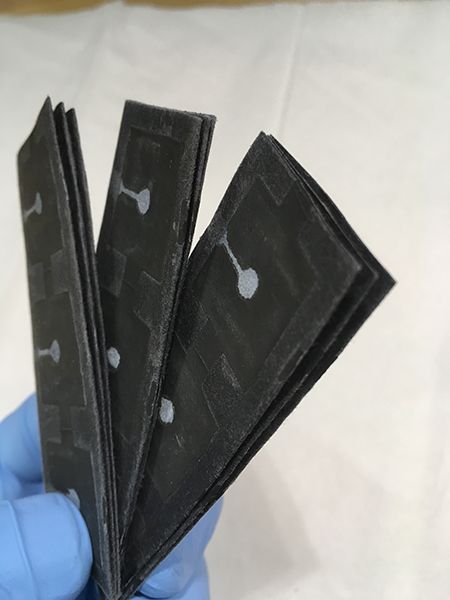This Spit-Powered Biobattery Is Made From a Single Sheet of Paper
Researchers at Binghamton University are developing inexpensive paper biobatteries to power simple sensors that monitor things like blood sugar
/https://tf-cmsv2-smithsonianmag-media.s3.amazonaws.com/filer/cc/7a/cc7a8dda-b3c7-433f-8fdf-83e25948b8d4/biobattery.jpg)
In the movie The Matrix, docile, semi-conscious humans are (spoiler) used as batteries for a great mechanical power. While this principle is obviously far-fetched, biobatteries are real. In the latest issue of Advanced Science News, scientists at the State University of New York-Binghamton describe a new way to use bacteria as batteries for small sensors. While biobatteries have been used for low-power electronics, they’ve never been simple or efficient enough for widespread use. So the Binghamton group has developed a new, easier, way to create and distribute microbial fuel cells, known as MFCs, using a single sheet of paper and freeze-dried bacteria that can be activated with just a little saliva.
An important purpose of MFCs, especially paper-based ones, is to enable the use of low-power electronics, particularly sensors, when a regular battery is both overkill and cost prohibitive. These won’t be charging anybody’s phones, but they’ll put out enough power to run an LED, or more likely, diagnostic sensors that could be used to detect HIV or cancer, monitor glucose, and more.
“[MFCs] can be used in resource-limited environments, like developing countries,” says creator Seokheun “Sean” Choi, an assistant professor of electrical and computer engineering at Binghamton. “However, the problem is the power. We can not use commercially available batteries or recent energy harvest technologies because they are too wasteful and too expensive for one-time use, disposable biosensors.”
Shewanella oneidensis, the bacteria used by Choi’s team, is often used in nanotechnology, due to its ability to reduce metals and live in oxygen-poor environments. It’s that reduction, in which positive ions are separated from negative ones, that makes the elongated, two-micrometer cells useful in biobatteries—the result is free charged particles that can be used as power.
Like a regular battery, a biobattery works by separating a positively charged terminal (called the cathode) from a negatively charged terminal (anode). As the bacteria digests a food source (usually glucose), its respiratory functions release electrons and protons, which can be used as energy.
“If we engineer their environment so the oxygen is limited, and then we provide a solid electrode, then we can capture those electrons,” says Choi.
Choi’s innovation has to do with the structure of paper MFCs. How, he asked, can you make an inexpensive paper biobattery that’s capable of powering simple electronic sensors, but is also easy to use and transport? His solution employed some new techniques, primarily freeze drying and folding.
The structure of the battery is formed from a sheet of chromatography paper, divided into a grid of creases. One section, made of silver nitrate and covered by wax, forms the cathode. Another section of conductive polymer acts as the anode, and a third contains a reservoir for the bacteria and its energy source. Choi preloads the reservoir with bacteria and freeze-dries them. In this way, they can be transported or stored for up to two weeks.
To use, simply spit into the reservoir and fold it into the center of the cathode and anode. Yes, spit; all it takes is a little bit of organic material for the bacteria to get going, and saliva contains glucose. It could be anything, but saliva is generally available and less objectionable than some of the alternatives.

Aaron Mazzeo, an assistant professor of mechanical and aerospace engineering at Rutgers, makes papertronics for flexible human-machine interfaces—things like wearable paper devices to monitor sweat for cortisol, an indicator of stress. A battery like Choi’s could be the power source he needs.
“We are going to continue to have the ongoing challenge of providing power to these devices,” says Mazzeo. “Having the electrical power allows you to do the diagnosis, but it could also potentially amplify the signals, so you might be able to detect smaller quantities. This is way out in the future, but this type of thing could be useful for not only measuring cortisol, but maybe even things like cholesterol or alcohol or other clinically relevant markers in the blood, urine or sweat.”
Both Mazzeo’s and Choi’s work is part of the growing and important field of papertronics. Scientists are finding more and better ways to put circuits, capacitors, batteries, and even solar cells and user interfaces (like Mazzeo’s group does) on paper. Prior to Choi’s work, the batteries that have run all these applications have been complicated affairs made up of multiple sheets of paper that have to be matched precisely.
“I think there’s a real potential for this field to contribute to society’s ongoing efforts in environmental stability, safety, communication, health and performance,” says Mazzeo.
But there’s always a need to power those electronics, so Choi still wants to make his batteries more powerful and efficient, and to do that he’s investigating different means of folding them and stacking them, as well as engineering bacteria to be better producers of power.